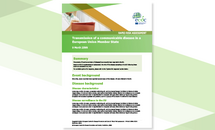Combined clonal and plasmid-mediated outbreak of carbapenemase-producing Enterobacterales, Lithuania, 2019–2020
Between 1 February 2019 and 7 January 2020, 223 cases of Klebsiella pneumoniae carbapenemase (KPC)-producing, carbapenem-resistant Enterobacterales (KPC-CRE) were detected in Lithuania, including cases with infections as well as carriage. This is a large increase in CRE cases in Lithuania compared with previous years.
The risk of further spread in the most-affected hospital, Hospital 1, is high, as a large number of cases were identified from multiple wards, and new cases were detected until at least 07 January 2020. This means that, while enhanced infection control measures have been implemented, the outbreak was still ongoing at the time of this assessment.
Executive summary
Lithuania reported an outbreak of carbapenem-resistant, and for some cases, colistin-resistant Enterobacterales, including 223 cases detected between 1 February 2019 and 7 January 2020. The majority of cases (208 cases) occurred in one single hospital (Hospital 1). Most of the carbapenem-resistant Enterobacterales (CRE) isolates detected from cases were Klebsiella pneumoniae (199 cases, 89%), followed by Escherichia coli (21 cases, 9%). Whole genome sequencing (WGS) of 97 isolates revealed one major strain of K. pneumoniae ST392 responsible for the outbreak in Hospital 1 and detected in five additional hospitals. This K. pneumoniae ST392 outbreak strain carried a plasmid containing the blaKPC-2 gene. The same plasmid was also found in isolates of carbapenem-resistant K. pneumoniae of different sequence types and in E. coli and Citrobacter spp., thus indicating plasmid-mediated spread of carbapenem resistance in addition to clonal expansion of one single CRE strain. The number of CRE cases reported here represents a large increase compared with the total number of CRE cases for the whole country in previous years (five and 12 cases in 2017 and 2018, respectively).
The risk of further spread of CRE in the most-affected hospital appears to persist as new cases continue to be detected at the time of this risk assessment update, despite the implementation of enhanced infection control measures. The risk of further spread in the Lithuanian healthcare system is also likely to be high as WGS data indicated that the outbreak strain had been detected in five hospitals in addition to Hospital 1. By contrast, the risk of transmission for individuals outside healthcare settings is low. There is also no evidence, so far, for cross-border transmission related to transfer of patients with CRE from the hospitals affected by the outbreak, to healthcare facilities in other countries.
This outbreak highlights the high transmissibility of CRE, and in particular KPC-producing K. pneumoniae in healthcare settings. The outbreak is further complicated by parallel clonal expansion and plasmid spread including to other species. Early detection of outbreaks and close cooperation between healthcare units, clinicians and public health services are crucial to control the spread of CRE in the hospitalised patient population. Moreover, this outbreak highlights the importance of early detection of CRE in countries and settings with low incidence. To improve early detection and the control of CRE high-risk clones, and to better target control measures in healthcare facilities, there is a need for increased laboratory capacity in the European Union (EU)/European Economic Area (EEA) to support outbreak investigations and surveillance with real-time WGS in order to avoid further spread.







